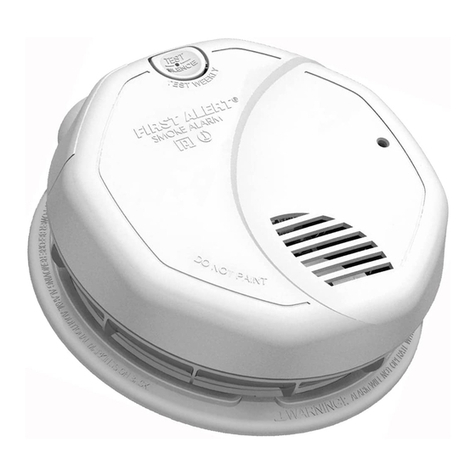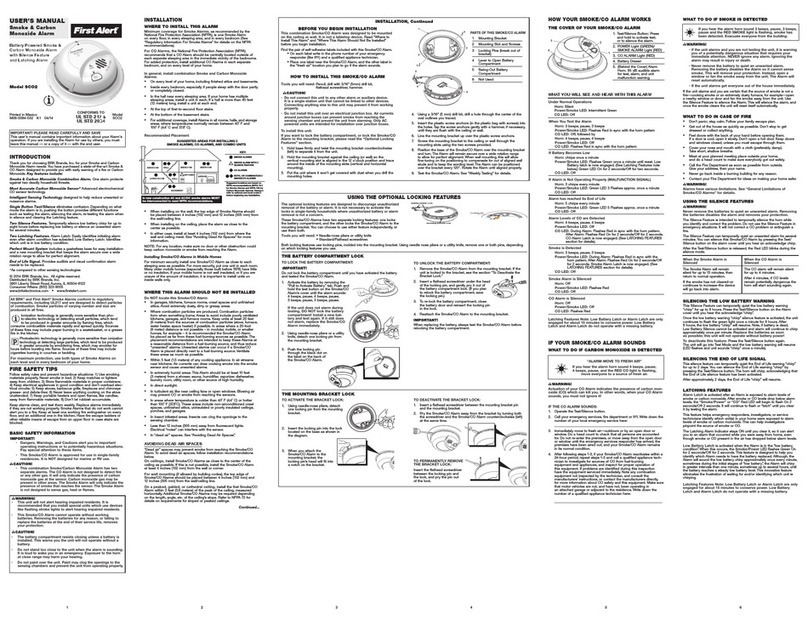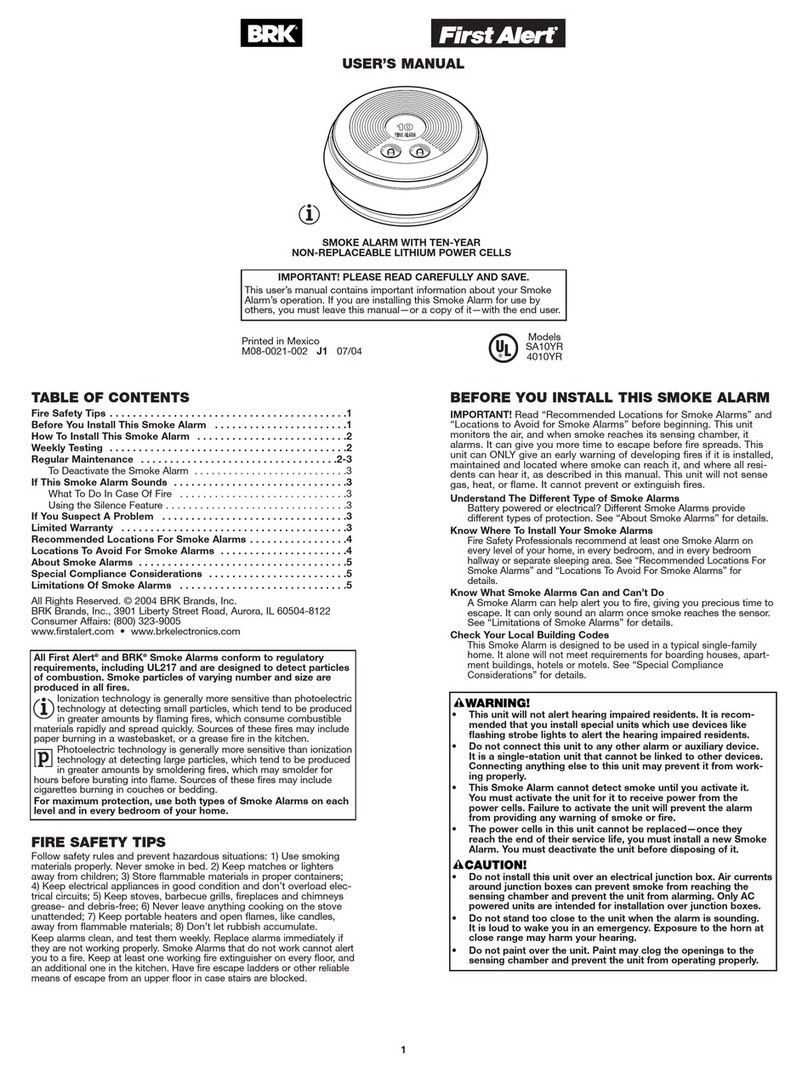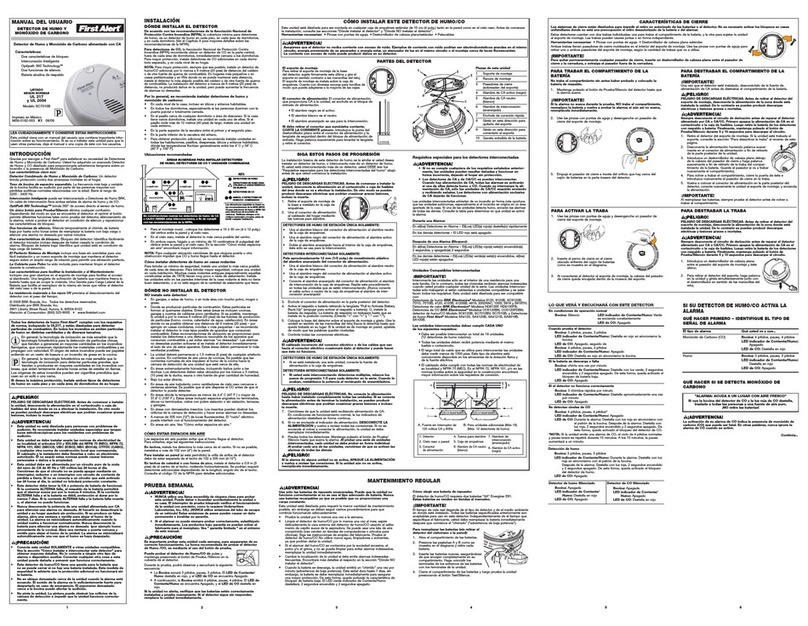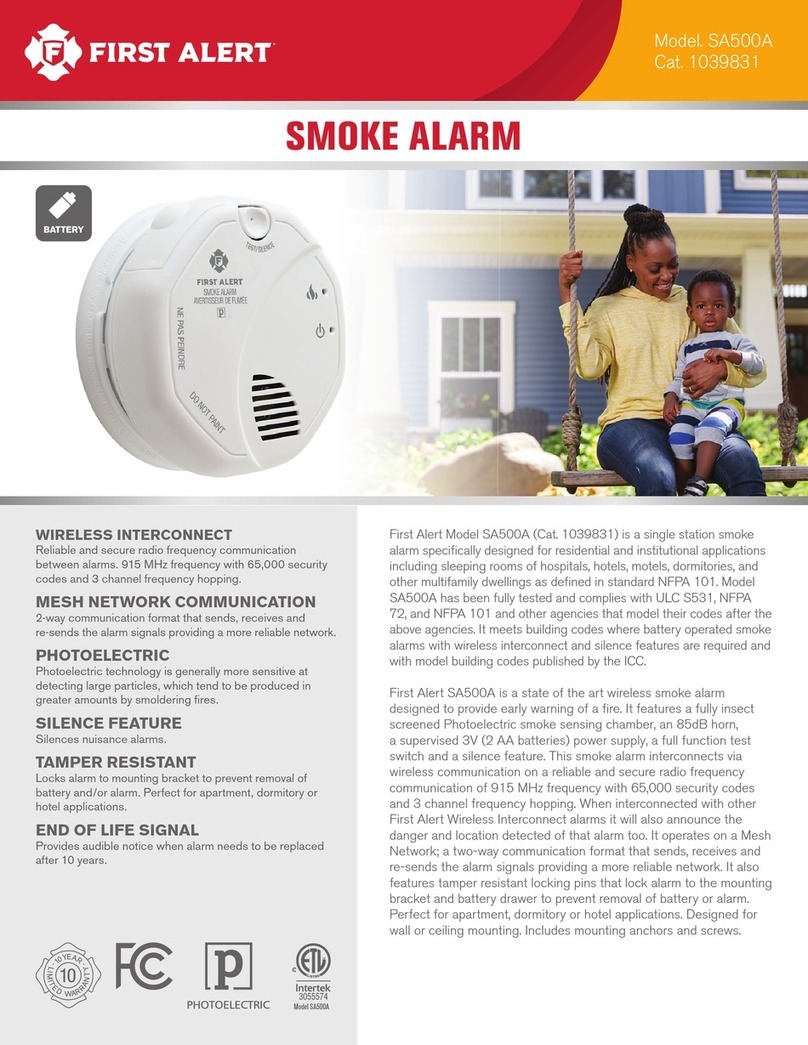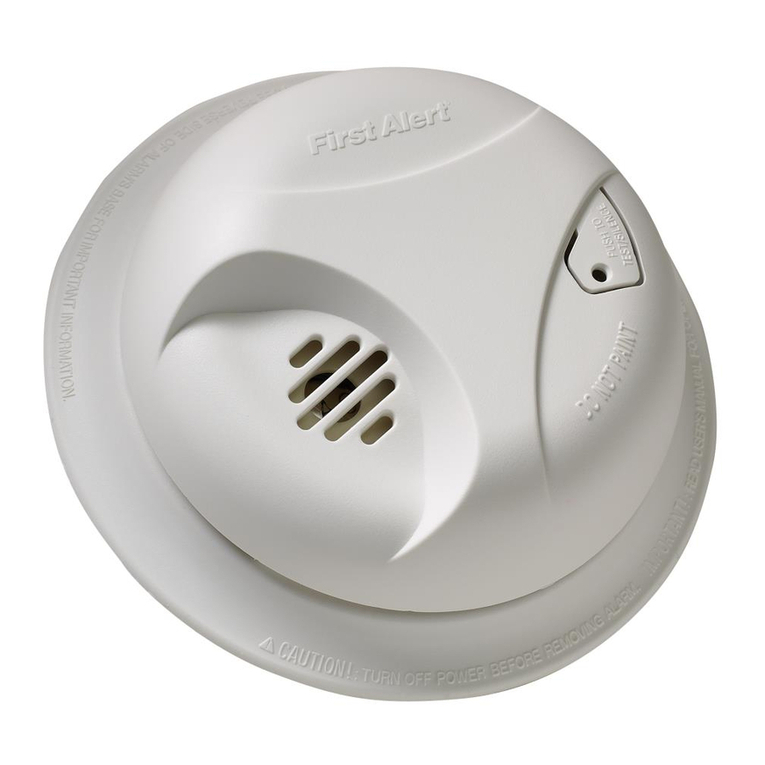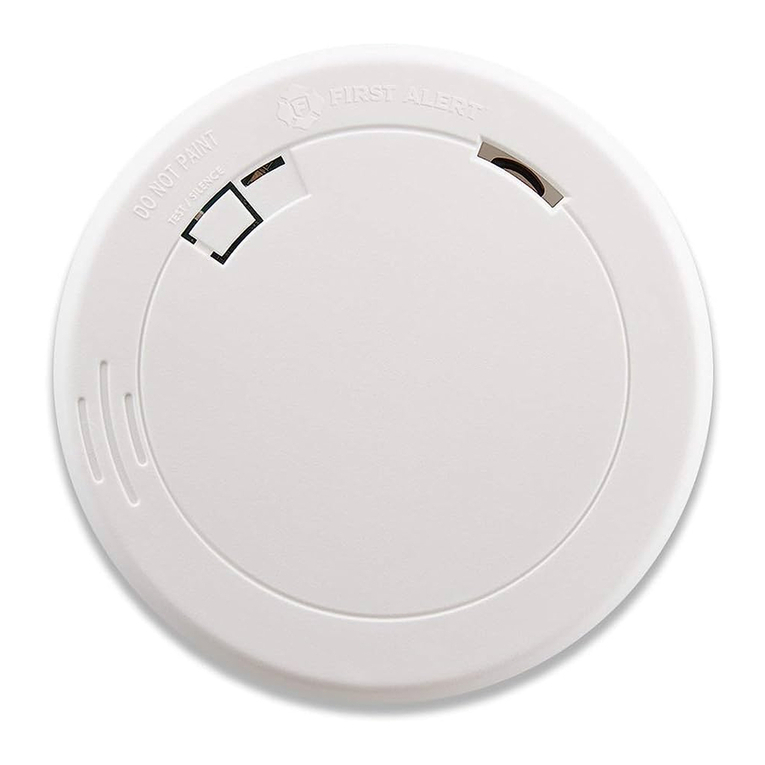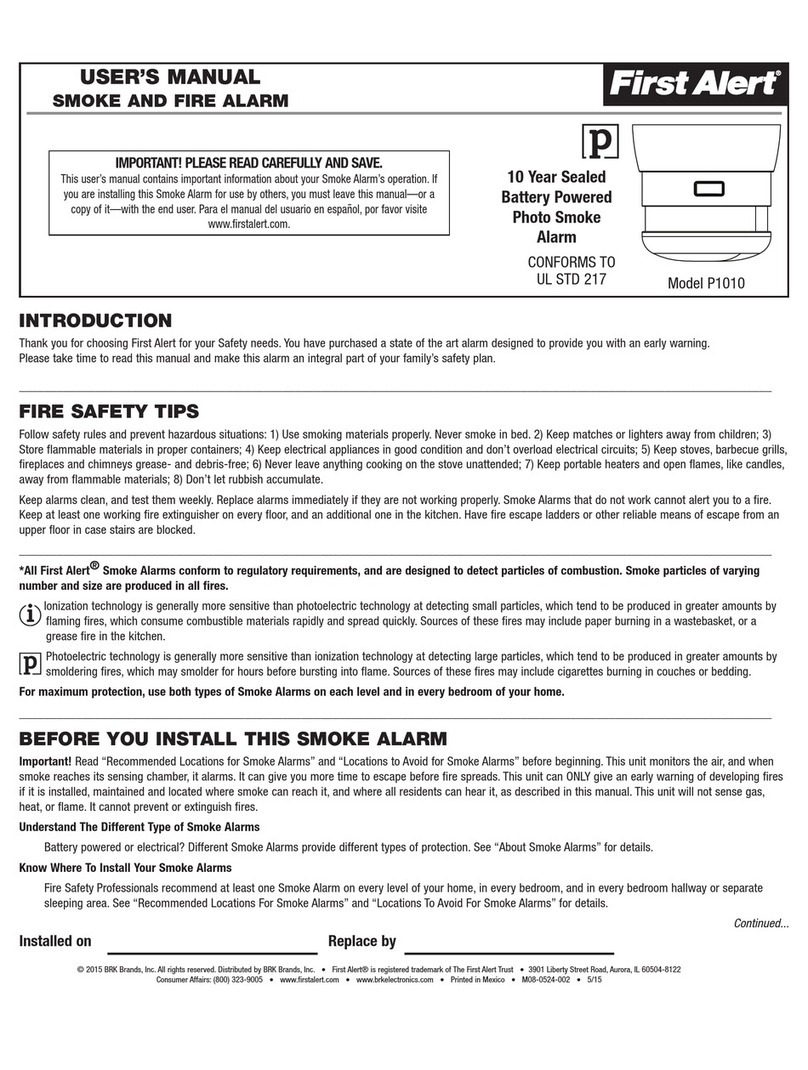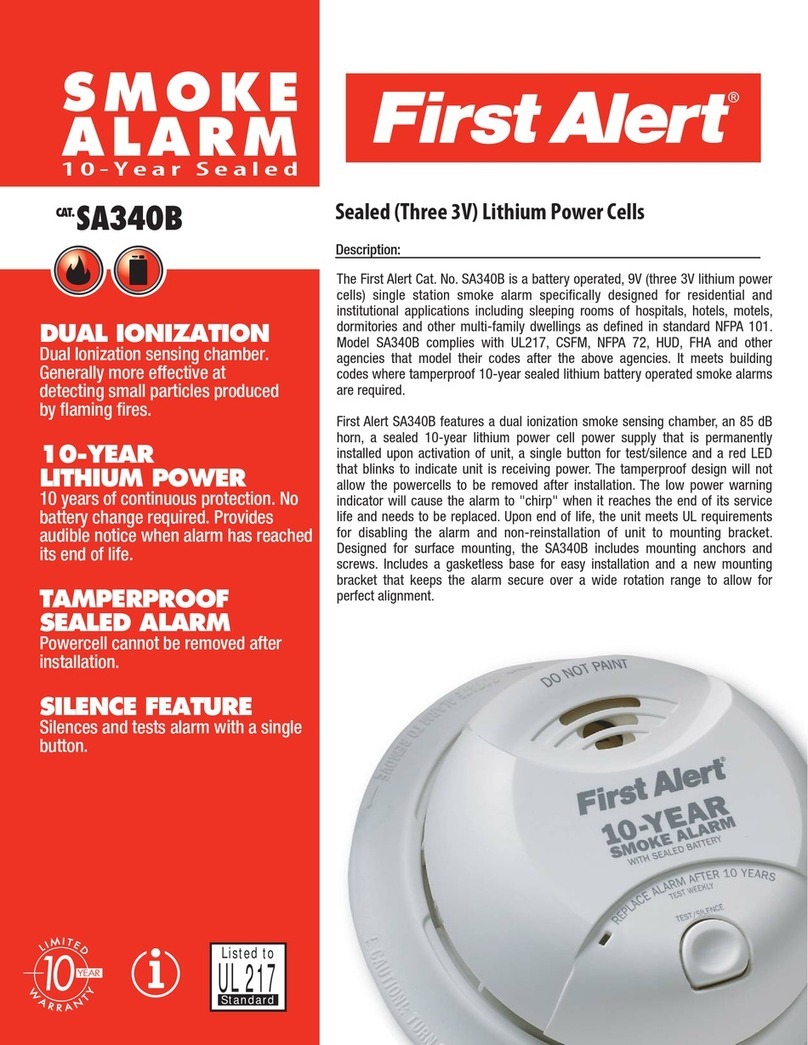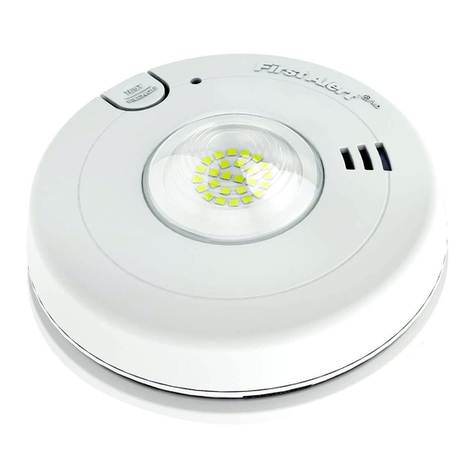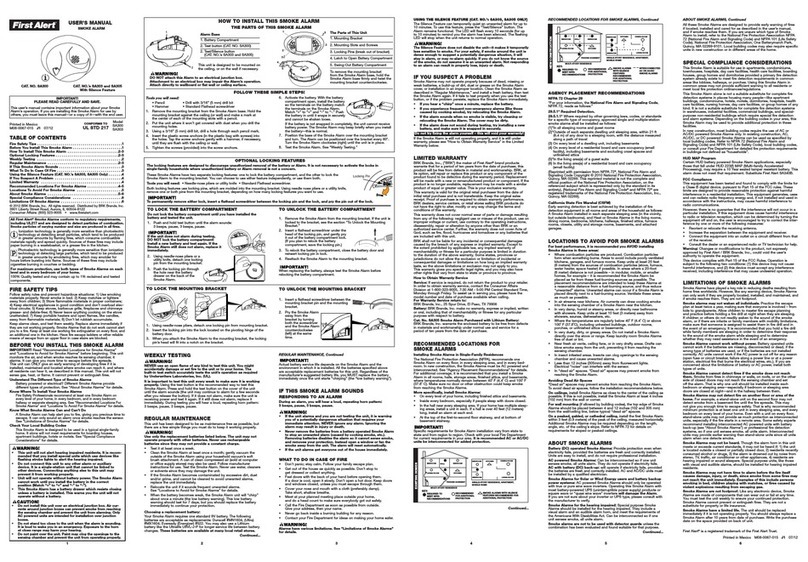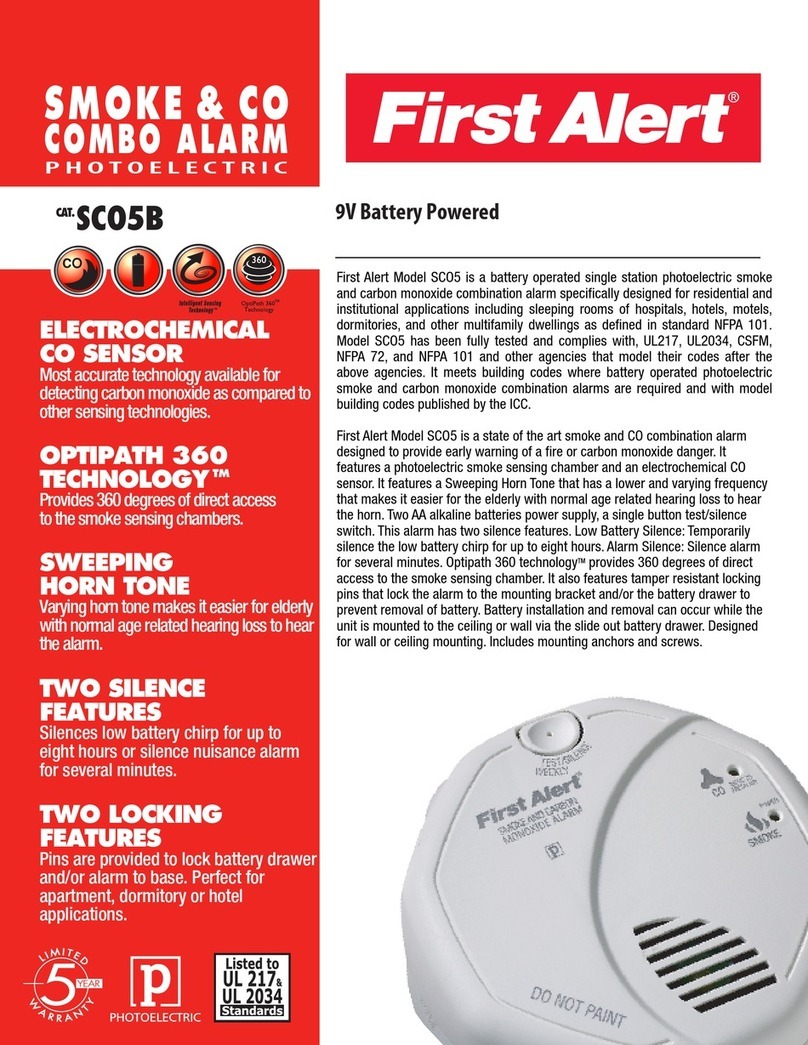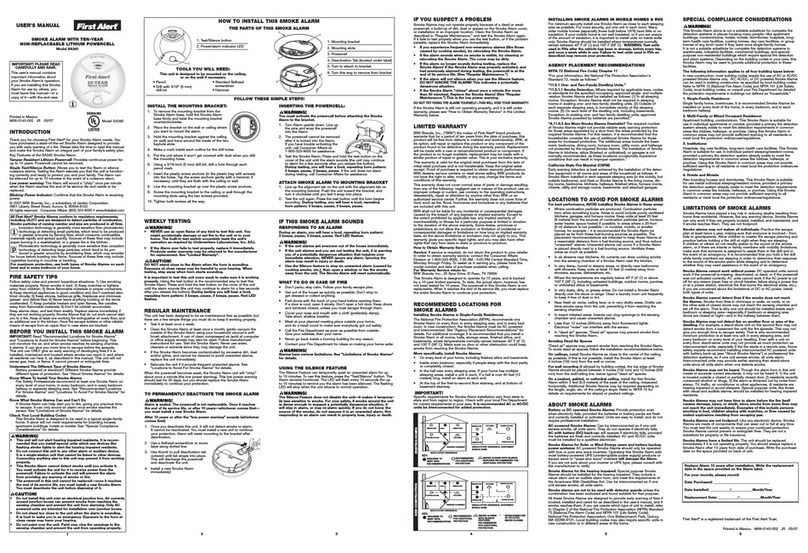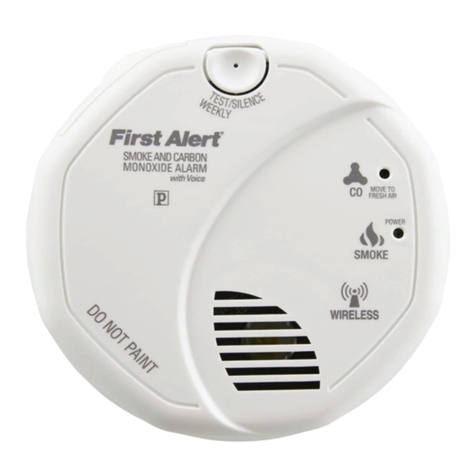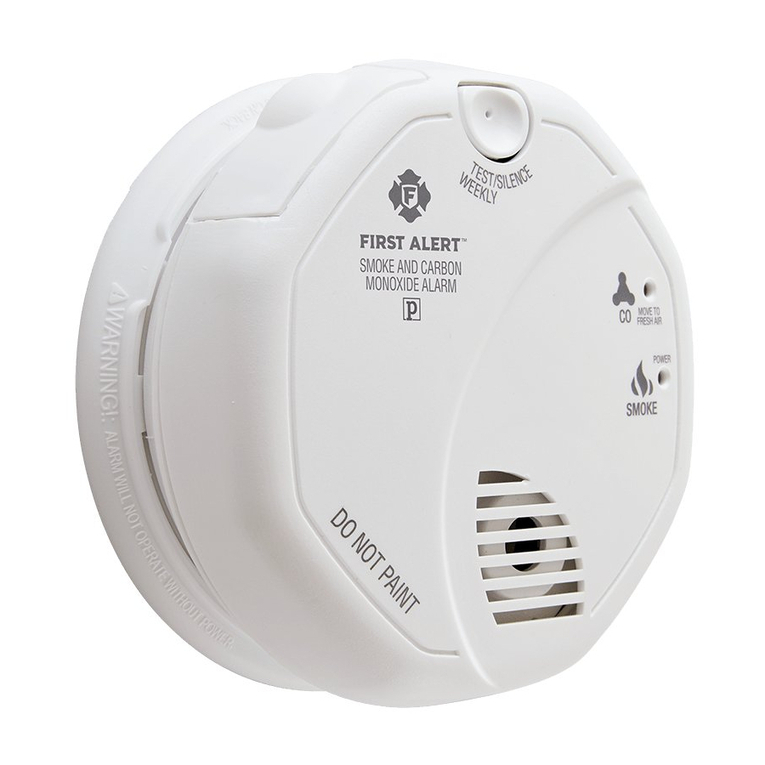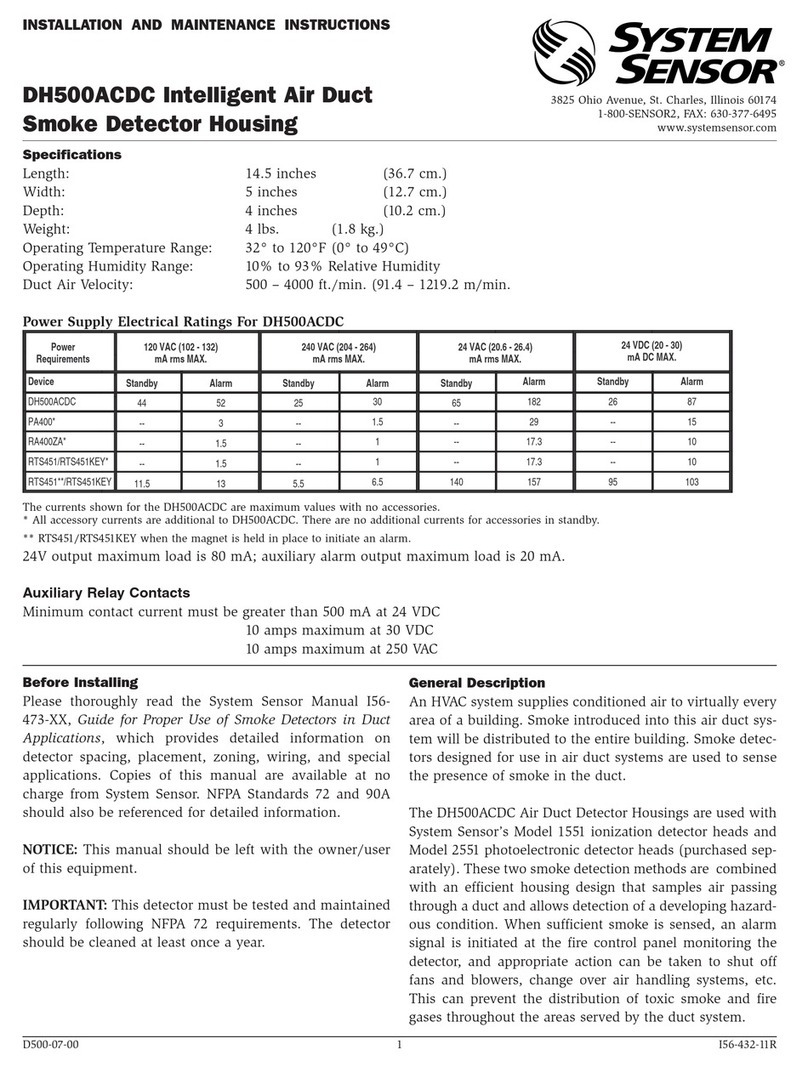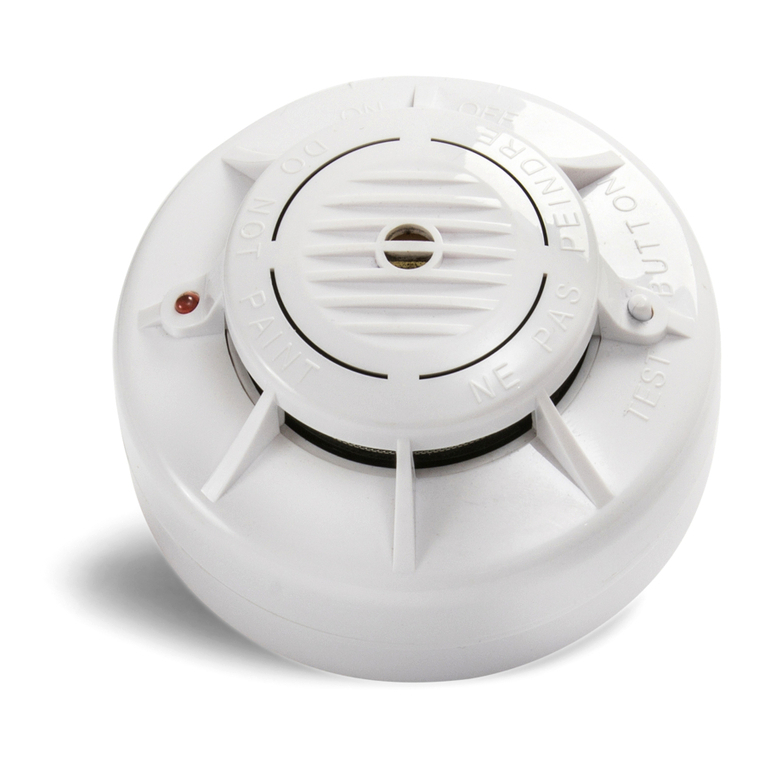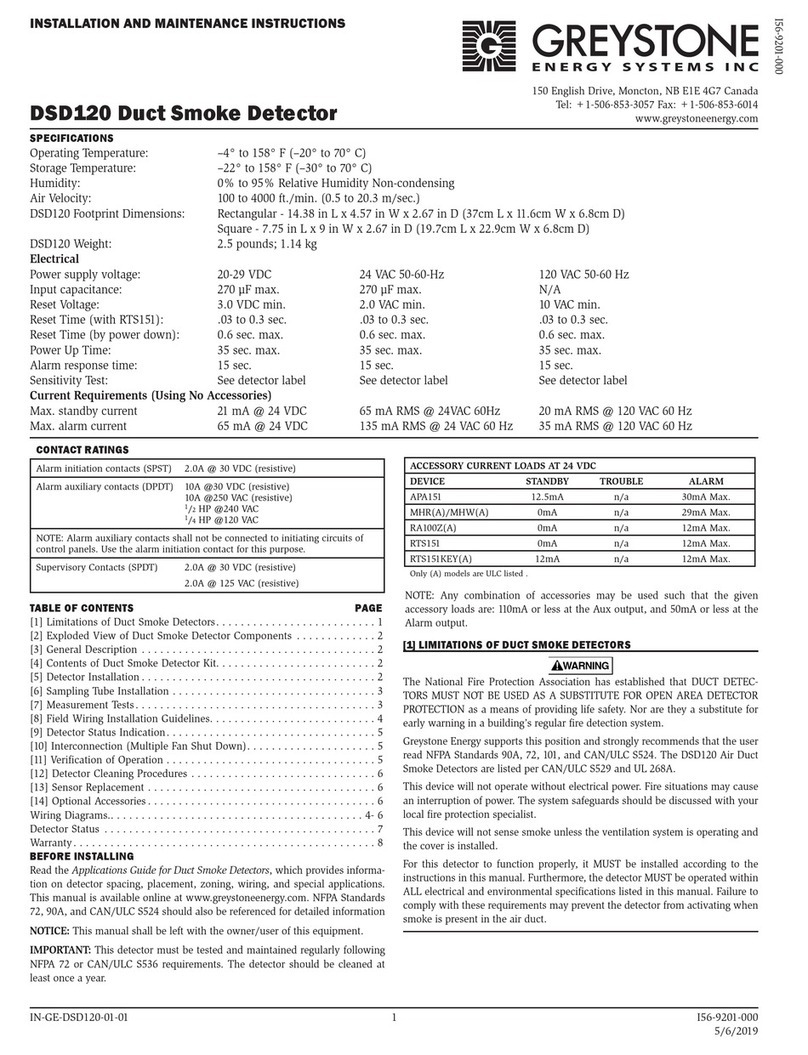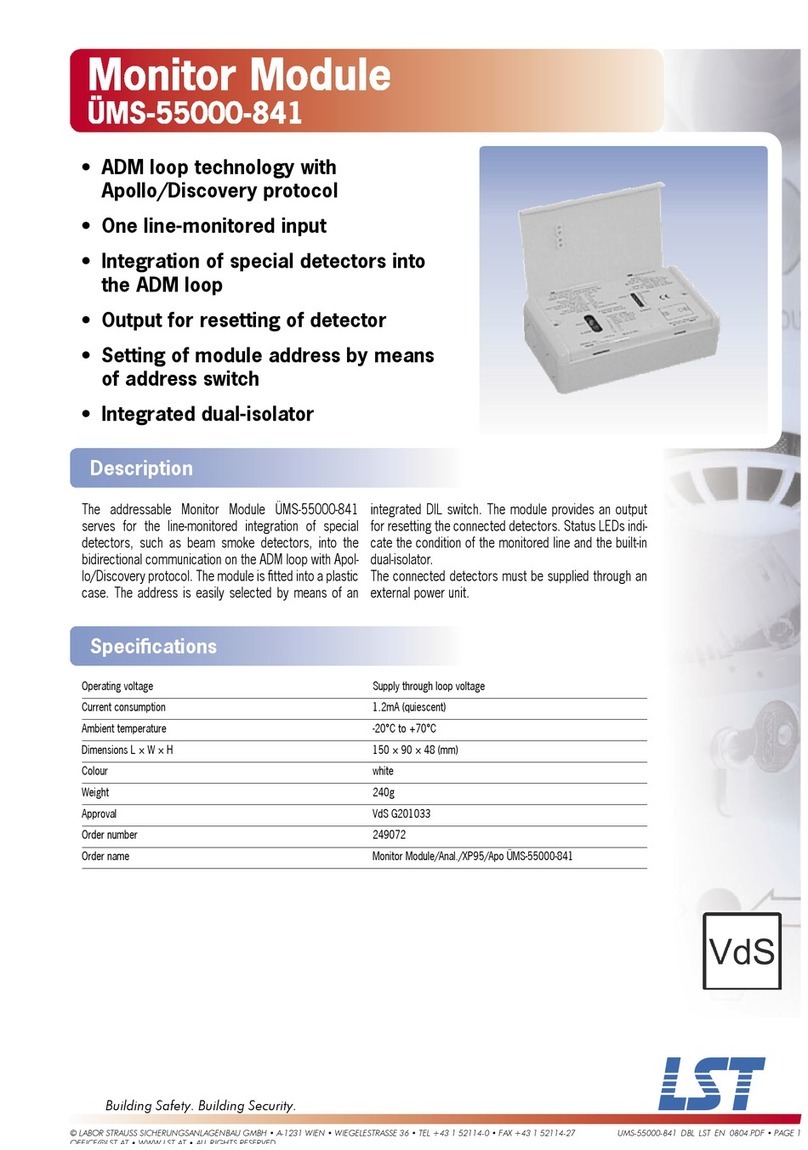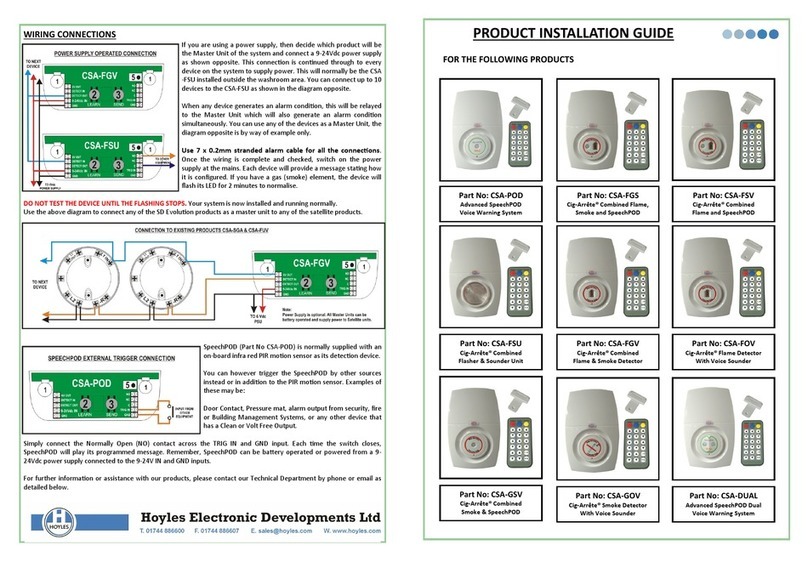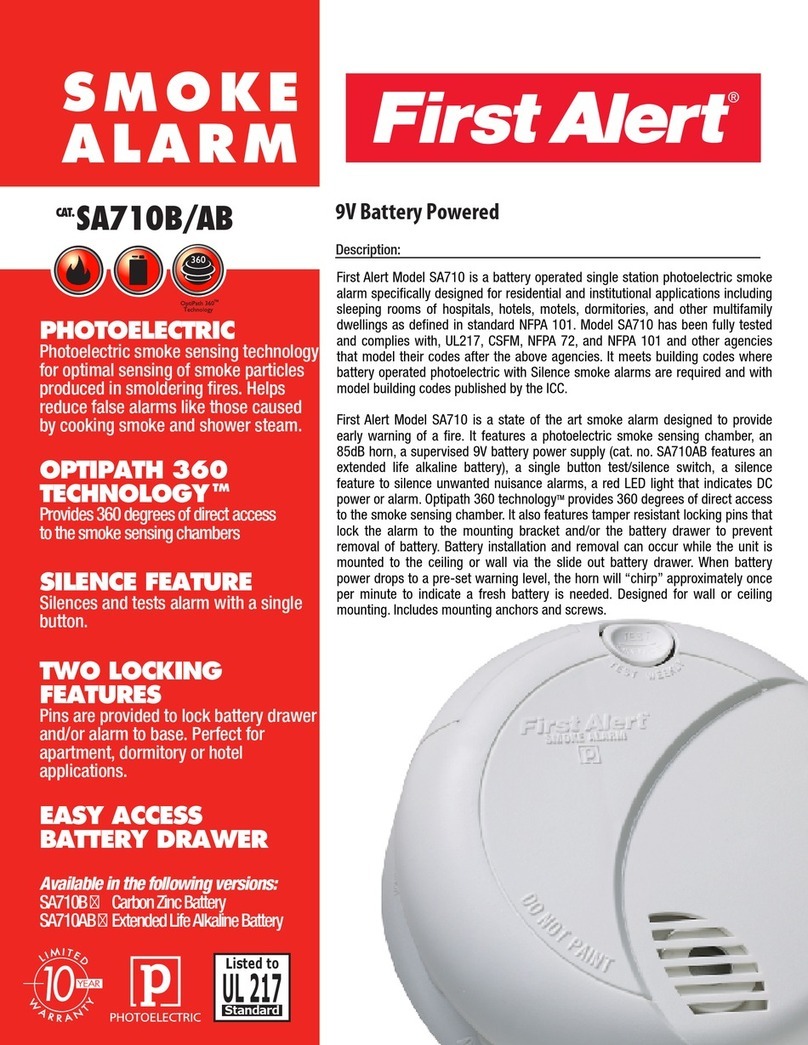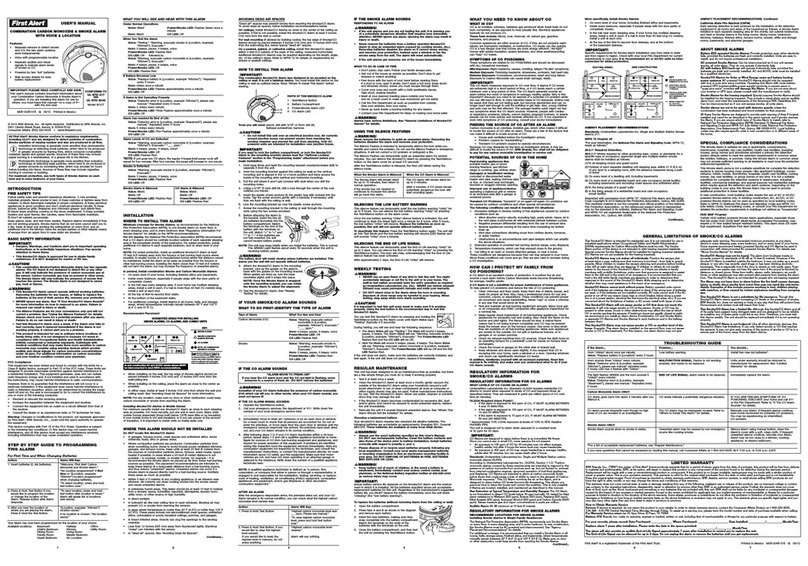Mo el SA320
Printe in Mexico
M08-0224-012 Q07/12
IMPORTANT! PLEASE READ CAREFULLY AND SAVE.
This user’s manual contains important information about your Smoke
Alarm’s operation. If you are installing this Smoke Alarm for use by
others, you must leave this manual—or a copy of it—with the en user.
INTRODUCTION
Thank you for choosing First Alert®for your Smoke Alarm nee s. You have
purchase a state of the art Smoke Alarm esigne to provi e you with an
early warning of a fire. Please take the time to rea this manual an make
this Smoke Alarm an integral part of your family’s safety plan.
Key Features of the SA320 Photo & Ion Combo Smoke Alarm:
Photo & Ion Smoke Sensors: Dual photoelectric an ionization smoke
sensing technologies for optimal sensing of smoke particles pro uce in
both flaming an smol ering fires.
Oti ath 360 TechnologyTM:Patente technology provi es 360˚ of irect
access to the smoke sensor.
Two Silence Features: Low Battery Silence temporarily silences low
battery chirp for up to eight hours before replacing low battery.
Alarm Silence silences an unwante alarm for several minutes.
Two Latching Features: Alarm Latch remembers which unit initiate an
alarm. Low Battery Latch visually i entifies which unit is in low battery
con ition.
Perfect Mount: Mounting bracket keeps alarm secure over a wi e rotation
range to allow for perfect alignment.
© 2012 BRK Bran s, Inc. All rights reserve . Distribute by BRK Bran s, Inc.
3901 Liberty Street Roa , Aurora, IL 60504-8122
Consumer Affairs: (800) 323-9005
www.firstalert.com • www.brkelectronics.com
FIRE SAFETY TIPS
Follow safety rules an prevent hazar ous situations: 1) Use smoking
materials properly. Never smoke in be . 2) Keep matches or lighters away
from chil ren; 3) Store flammable materials in proper containers;
4) Keep electrical appliances in goo con ition an on’t overloa electrical
circuits; 5) Keep stoves, barbecue grills, fireplaces an chimneys grease-
an ebris-free; 6) Never leave anything cooking on the stove unatten e ;
7) Keep portable heaters an open flames, like can les, away from flammable
materials; 8) Don’t let rubbish accumulate.
Keep alarms clean, an test them weekly. Replace alarms imme iately if they
are not working properly. Smoke Alarms that o not work cannot alert you to a
fire. Keep at least one working fire extinguisher on every floor, an an a itional
one in the kitchen. Have fire escape la ers or other reliable means of escape
from an upper floor in case stairs are blocke .
BEFORE YOU INSTALL THIS SMOKE ALARM
IMPORTANT! Rea “Recommen e Locations for Smoke Alarms” an
“Locations to Avoi for Smoke Alarms” before beginning. This unit monitors
the air, an when smoke reaches its sensing chamber, it alarms. It can give
you more time to escape before fire sprea s. This unit can ONLY give an early
warning of eveloping fires if it is installe , maintaine an locate where
smoke can reach it, an where all resi ents can hear it, as escribe in this
manual. This unit will not sense gas, heat, or flame. It cannot prevent or
extinguish fires.
Un erstan The Different Type of Smoke Alarms
Battery powere or electrical? Different Smoke Alarms provi e ifferent
types of protection. See “About Smoke Alarms” for etails.
Know Where To Install Your Smoke Alarms
Fire Safety Professionals recommen at least one Smoke Alarm on every
level of your home, in every be room, an in every be room hallway or
separate sleeping area. See “Recommen e Locations For Smoke Alarms”
an “Locations To Avoi For Smoke Alarms” for etails.
Know What Smoke Alarms Can an Can’t Do
A Smoke Alarm can help alert you to fire, giving you precious time to
escape. It can only soun an alarm once smoke reaches the sensor.
See “Limitations of Smoke Alarms” for etails.
Check Your Local Buil ing Co es
This Smoke Alarm is esigne to be use in a typical single-family home.
It alone will not meet requirements for boar ing houses, apartment
buil ings, hotels or motels. See “Special Compliance Consi erations”
for etails.
5 6 71 2 3
All First Alert®an BRK®Smoke Alarms conform to regulatory
requirements, inclu ing UL217 an are esigne to etect particles of
combustion. Smoke particles of varying number an size are pro uce
in all fires.
Ionization technology is generally more sensitive than photoelectric
technology at etecting small particles, which ten to be pro uce
in greater amounts by flaming fires, which consume combustible
materials rapi ly an sprea quickly. Sources of these fires may inclu e
paper burning in a wastebasket, or a grease fire in the kitchen.
Photoelectric technology is generally more sensitive than ionization
technology at etecting large particles, which ten to be pro uce in
greater amounts by smol ering fires, which may smol er for hours
before bursting into flame. Sources of these fires may inclu e cigarettes
burning in couches or be ing.
For maximum protection, use both types of Smoke Alarms on each
level an in every be room of your home.
USER’S MANUAL
SMOKE ALARMS
• This unit will not alert hearing impaire resi ents. It is recom-
men e that you install special units which use evices like
flashing strobe lights to alert hearing impaire resi ents.
• This Smoke Alarm must have battery power to operate.
The Smoke Alarm cannot work until you install the batteries
in the correct position (Match “+” to “+” an “-” to “-”).
• Never remove the batteries from a battery operate unit to
stop an unwante alarm (cause by cooking smoke, etc.).
Instea open a win ow or fan the smoke away from the unit.
The alarm will reset automatically.
• Do not install this unit over an electrical junction box. Only AC
powere units are inten e for installation over junction boxes.
• This Smoke Alarm has a battery rawer which resists closing
unless batteries are installe . This warns you the unit will not
operate un er DC power without batteries.
• Do not stan too close to the unit when the alarm is soun ing.
It is lou to wake you in an emergency. Exposure to the horn at
close range may harm your hearing.
• Do not paint over the unit. Paint may clog the openings to the
sensing chambers an prevent the unit from operating properly.
4
OPTIONAL LOCKING FEATURES
The locking features are esigne to iscourage unauthorize removal of the batteries or Alarm. It is not necessary to activate the locks in single-family
househol s where unauthorize battery or Alarm removal is not a concern.
These Smoke Alarms have two separate locking features: one to lock the battery compartment, an the other to lock the Smoke Alarm
to the mounting bracket. You can choose to use either feature in epen ently, or use them both.
Tools you will nee : • Nee le-nose pliers or utility knife • Stan ar Flathea screw river.
Both locking features use locking pins, which are mol e into the mounting bracket. Using nee le-nose pliers or a utility knife, remove
one or both pins from the mounting bracket, epen ing on how many locking features you want to use.
To permanently remove either lock, insert a flathea screw river between the locking pin an the lock, an pry the pin out of the lock.
TO LOCK THE BATTERY COMPARTMENT
Do not lock the battery compartment until you have installe the
batteries an teste the alarm.
1. Push an hol Test button until the alarm soun s: 3 beeps, pause,
3 beeps, pause. LED flashes once every secon .
If the unit oes not alarm uring testing, DO NOT lock the battery
compartment! Install new batteries an test again. If the Smoke
Alarm still oes not alarm, replace it imme iately.
2. Using nee le-nose pliers or a utility knife, etach one locking pin
from the mounting bracket.
3. Push the locking pin through the hole near the battery rawer on the
back of the Smoke Alarm.
TO UNLOCK THE BATTERY COMPARTMENT
1. Remove the Smoke Alarm from the mounting
bracket. If the unit is locke to the bracket, see
the section “To Unlock the Mounting Bracket.”
2. Insert a flathea screw river un er the hea
of the locking pin, an gently pry it out of the
battery compartment lock. (If you plan to relock
the battery compartment, save the locking pin.)
3. To relock the battery compartment, close the
battery oor an reinsert locking pin in lock.
4. Reattach the Smoke Alarm to the mounting
bracket.
When replacing the batteries, always test the Smoke Alarm before relocking
the battery compartment.
TO UNLOCK THE MOUNTING BRACKET
1. Insert a flathea screw river between the
mounting bracket pin an the mounting bracket.
2. Pry the Smoke Alarm away from the bracket by
turning both the screw river an the Smoke
Alarm counterclockwise (left) at the same time.
TO LOCK THE MOUNTING BRACKET
1. Using nee le-nose pliers, etach one locking pin from mounting bracket.
2. Insert the locking pin into the lock locate
opposite from the battery rawer as shown
in the iagram.
3. When you attach the Smoke Alarm to the mounting bracket, the locking
pin’s hea will fit into a notch on the bracket.
Locking Features (Continued)
Printe in Mexico M08-0224-012 Q07/12
First Alert®is a registere tra emark of the First Alert Trust.
BRK®is a registere tra emark of BRK Bran s, Inc.
WEEKLY TESTING
• NEVER use an open flame of any kin to test this unit. You might
acci entally amage or set fire to the unit or to your home. The built-
in test switch accurately tests the unit’s operation as require by
Un erwriters Laboratories, Inc. (UL).
• If the Alarm ever fails to test properly, replace it imme iately.
Pro ucts un er warranty may be returne to the manufacturer
for replacement. See “Limite Warranty” at the en of this manual.
DO NOT stan close to the Alarm when the horn is soun ing. Exposure
at close range may be harmful to your hearing. When testing, step away
when horn starts soun ing.
It is important to test this unit every week to make
sure it is working properly. Using the test button is the
recommen e way to test this Smoke Alarm.
Press an hol the Test/Silence button on the cover of the
unit until the alarm soun s (the unit may continue to alarm
for a few secon s after you release the button). If it oes
not alarm, make sure the unit is receiving power an test
it again. If it still oes not alarm, replace it imme iately.
During testing, you will hear a lou , repeating horn pattern: 3 beeps,
pause, 3 beeps, pause. LED flashes once every secon .
When testing a series of interconnecte units you must test each unit
in ivi ually. Make sure all units alarm when each one is teste .
REGULAR MAINTENANCE
This unit has been esigne to be as maintenance-free as possible, but there
are a few simple things you must o to keep it working properly:
•Test it at least once a week.
• Clean the Smoke Alarm at least once a month; gently vacuum the
outsi e of the Smoke Alarm using your househol vacuum’s soft brush
attachment. Test the Smoke Alarm. Never use water, cleaners or solvents
since they may amage the unit.
•If the Smoke Alarm becomes contaminate by excessive irt, ust an /or
grime, an cannot be cleane to avoi unwante alarms, replace the
unit imme iately.
•Relocate the unit if it soun s frequent unwante alarms. See “Locations
To Avoi For Smoke Alarms” for etails.
•When the batteries become weak, the Smoke Alarm will “chirp” about
once a minute (the low battery warning). This warning shoul last 7 ays,
but you shoul replace the batteries imme iately to continue your
protection.
UNDERSTANDING THE INDICATOR LIGHTS
AND ALARM HORN PATTERNS
Note: To conserve batteries, both "Latching" features last for 15 minutes
an are then turne off.
IF THIS SMOKE ALARM SOUNDS
RESPONDING TO AN ALARM
During an alarm, you will hear a lou , repeating horn pattern: 3 beeps,
pause, 3 beeps, pause.
• If the unit alarms an you are not testing the unit, it is warning you of a
potentially angerous situation that requires your imme iate attention.
NEVER ignore any alarm. Ignoring the alarm may result in injury or
eath.
• Never remove the batteries to quiet an unwante alarm. Removing
the batteries isables the Alarm so it cannot sense smoke. This will
remove your protection. Instea , open a win ow or
fan the smoke
away from the unit. The Alarm will reset automatically.
• If the unit alarms get everyone out of the house imme iately.
If the unit alarms an you are certain that the source of smoke is not a fire—
cooking smoke or an extremely usty furnace, for example—open a nearby
win ow or oor an fan the smoke away from the unit (Use the Silence Feature
to silence the Alarm). This will silence the alarm, an once the smoke clears the
unit will reset itself automatically.
WHAT TO DO IN CASE OF FIRE
•Don’t panic; stay calm. Follow your family escape plan.
• Get out of the house as quickly as possible. Don’t stop to
get resse or collect anything.
• Feel oors with the back of your han before opening them.
If a oor is cool, open it slowly. Don’t open a hot oor. Keep oors
an win ows close , unless you must escape through them.
•Cover your nose an mouth with a cloth (preferably amp).
Take short, shallow breaths.
•Meet at your planne meeting place outsi e your home,
an o a hea count to make sure everybo y got out safely.
• Call the Fire Department as soon as possible from outsi e.
Give your a ress, then your name.
• Never go back insi e a burning buil ing for any reason.
•Contact your Fire Department for i eas on making your home safer.
Alarms have various limitations. See "Limitations of Smoke Alarms" for
etails.
IF YOU SUSPECT A PROBLEM
Smoke Alarms may not operate properly because of ea , missing or weak
batteries, a buil -up of irt, ust or grease on the Smoke Alarm cover, or
installation in an improper location. Clean the Smoke Alarm as escribe in
“Regular Maintenance,” an install fresh batteries, then test the Smoke Alarm
again. If it fails to test properly when you use the test button, or if the problem
persists, replace the Smoke Alarm imme iately.
•If you hear a “chirp” approximately once a minute, replace the
batteries.
•If you experience frequent non-emergency alarms (like those cause
by cooking smoke), try relocating the Smoke Alarm.
• If the alarm soun s when no smoke is visible, try cleaning or
relocating the Smoke Alarm. The cover may be irty.
• If the alarm oes not soun uring testing, try installing new batteries,
an make sure they are installe correctly.
If the Smoke Alarm is still not operating properly, an it is still un er warranty,
please see “How to Obtain Warranty Service” in the Limite Warranty.
Do not try fixing the alarm yourself – this will voi your warranty!
LIMITED WARRANTY
BRK Bran s, Inc., ("BRK") the maker of First Alert®bran an BRK®bran
pro ucts, warrants that for a perio of ten years from the ate of purchase,
this pro uct will be free from efects in material an workmanship.
BRK, at its option, will repair or replace this pro uct or any component of
the pro uct foun to be efective uring the warranty perio . Replacement
will be ma e with a new or remanufacture pro uct or component. If the
pro uct is no longer available, replacement may be ma e with a similar
pro uct of equal or greater value. This is your exclusive warranty.
This warranty is vali for the original retail purchaser from the ate of initial
retail purchase an is not transferable. Keep the original sales receipt.
Proof of purchase is require to obtain warranty performance.
BRK ealers, service centers, or retail stores selling BRK pro ucts o not
have the right to alter, mo ify or any way change the terms an con itions
of this warranty.
This warranty oes not cover normal wear of parts or amage resulting
from any of the following: negligent use or misuse of the pro uct, use on
improper voltage or current, use contrary to the operating instructions,
isassembly, repair or alteration by anyone other than BRK or an authorize
service center. Further, the warranty oes not cover Acts of Go , such as
fire, floo , hurricanes an torna oes or any batteries that are inclu e with
this unit.
BRK shall not be liable for any inci ental or consequential amages
cause by the breach of any express or implie warranty. Except to the
extent prohibite by applicable law, any implie warranty of merchantability
or fitness for a particular purpose is limite in uration to the uration of
the above warranty. Some states, provinces or juris ictions o not allow
the exclusion or limitation of inci ental or consequential amages or
limitations on how long an implie warranty lasts, so the above limitations
or exclusion may not apply to you. This warranty gives you specific legal
rights, an you may also have other rights that vary from state to state or
province to province.
How to Obtain Warranty Service
Service: If service is require , o not return the pro uct to your retailer.
In or er to obtain warranty service, contact the Consumer Affairs Division
at 1-800-323-9005, 7:30 AM - 5:00 PM Central Stan ar Time, Mon ay
through Fri ay. To assist us in serving you, please have the mo el number
an ate of purchase available when calling.
For Warranty Service return to:
BRK Bran s, Inc., 25 Spur Drive, El Paso, TX 79906
Battery: BRK Bran s, Inc. make no warranty, express or implie , written or
oral, inclu ing that of merchantability or fitness for any particular purpose
with respect to battery.
RECOMMENDED LOCATIONS FOR
SMOKE ALARMS
Installing Smoke Alarms in Single-Family Resi ences
The National Fire Protection Association (NFPA), recommen s one Smoke
Alarm on every floor, in every sleeping area, an in every be room. In new
construction, the Smoke Alarms must be AC powere an interconnecte .
See “Agency Placement Recommen ations” for etails. For a itional cover-
age, it is recommen e that you install a Smoke Alarm in all rooms, halls,
storage areas, finishe attics, an basements, where temperatures normally
remain between 40˚ F (4.4˚ C) an 100˚ F (37.8˚ C). Make sure no oor or
other obstruction coul keep smoke from reaching the Smoke Alarms.
More specifically, install Smoke Alarms:
• On every level of your home, inclu ing finishe attics an basements.
• Insi e every be room, especially if people sleep with the oor partly or
completely close .
• In the hall near every sleeping area. If your home has multiple sleeping
areas, install a unit in each. If a hall is more than 40 feet long (12 meters),
install a unit at each en .
• At the top of the first-to-secon floor stairway, an at the bottom
of the basement stairway.
Specific requirements for Smoke Alarm installation vary from state to state
an from region to region. Check with your local Fire Department for current
requirements in your area. It is recommen e AC or AC/DC units be inter-
connecte for a e protection.
LIMITATIONS OF SMOKE ALARMS
Smoke Alarms have playe a key role in re ucing eaths resulting from home
fires worl wi e. However, like any warning evice, Smoke Alarms can only
work if they are properly locate , installe , an maintaine , an if smoke
reaches the Alarms. They are not foolproof.
Smoke alarms may not waken all in ivi uals. Practice the escape plan
at least twice a year, making sure that everyone is involve – from ki s to
gran parents. Allow chil ren to master fire escape planning an practice
before hol ing a fire rill at night when they are sleeping. If chil ren or others
o not rea ily waken to the soun of the smoke alarm, or if there are infants
or family members with mobility limitations, make sure that someone is
assigne to assist them in fire rill an in the event of an emergency. It is
recommen e that you hol a fire rill while family members are sleeping in
or er to etermine their response to the soun of the smoke alarm while
sleeping an to etermine whether they may nee assistance in the event
of an emergency.
Smoke Alarms cannot work without power. Battery operate units cannot
work if the batteries are missing, isconnecte or ea , if the wrong type
of batteries are use , or if the batteries are not installe correctly. AC units
cannot work if the AC power is cut off for any reason (open fuse or circuit
breaker, failure along a power line or at a power station, electrical fire that
burns the electrical wires, etc.). If you are concerne about the limitations
of battery or AC power, install both types of units.
Smoke Alarms cannot etect fires if the smoke oes not reach the
Alarms. Smoke from fires in chimneys or walls, on roofs, or on the other si e
of close oors may not reach the sensing chamber an set off the Alarm.
That is why one unit shoul be installe insi e each be room or sleeping
area—especially if be room or sleeping area oors are close at night—an
in the hallway between them.
Smoke Alarms may not etect fire on another floor or area of the
welling. For example, a stan -alone unit on the secon floor may not etect
smoke from a basement fire until the fire sprea s. This may not give you
enough time to escape safely. That is why recommen e minimum protection
is at least one unit in every sleeping area, an every be room on every level
of your welling. Even with a unit on every floor, stan -alone units may not
provi e as much protection as interconnecte units, especially if the fire starts
in a remote area. Some safety experts recommen installing interconnecte
AC powere units with battery back-up (see “About Smoke Alarms”) or
professional fire etection systems, so if one unit senses smoke, all units
alarm. Interconnecte units may provi e earlier warning than stan -alone
units since all units alarm when one etects smoke.
Smoke Alarms may not be hear . Though the alarm horn in this unit meets
or excee s current stan ar s, it may not be hear if: 1) the unit is locate
outsi e a close or partially close oor, 2) resi ents recently consume
alcohol or rugs, 3) the Alarm is rowne out by noise from stereo, TV, traffic,
air con itioner or other appliances, 4) resi ents are hearing impaire or soun
sleepers. Special purpose units, like those with visual an au ible alarms,
shoul be installe for hearing impaire resi ents.
Smoke Alarms may not have time to alarm before the fire itself causes
amage, injury, or eath, since smoke from some fires may not reach
the unit imme iately. Examples of this inclu e persons smoking in be ,
chil ren playing with matches, or fires cause by violent explosions
resulting from escaping gas.
Smoke Alarms are not foolproof. Like any electronic evice, Smoke Alarms
are ma e of components that can wear out or fail at any time. You must test
the unit weekly to ensure your continue protection. Smoke Alarms cannot
prevent or extinguish fires. They are not a substitute for property or life
insurance.
Smoke Alarms have a limite life. The unit shoul be replace imme iately
if it is not operating properly. You shoul always replace a Smoke Alarm after
10 years from ate of purchase. Write the purchase ate on the space provi e
on back of unit.
USING THE SILENCE FEATURE
The Silence Feature can temporarily quiet an unwante alarm for up to 15
minutes.
The Silence Feature oes not isable the unit—it makes it temporarily
less sensitive to smoke. For your safety, if smoke aroun the unit is ense
enough to suggest a potentially angerous situation, the unit will stay in
alarm or may re-alarm quickly. If you o not know the source of the
smoke, o not assume it is an unwante alarm. Not respon ing to an
alarm can result in property loss, injury, or eath.
The Silence Feature on these units can temporarily quiet an unwante alarm for
up to 15 minutes. To use this feature, press the Test/Silence button on the cover.
If the unit will not silence an no heavy smoke is present, or if it stays in
silence mo e continuously, it shoul be replace imme iately.
Mdel SA320
with Silence
Battery Powere
Photo & Ion Smoke Alarm
TABLE OF CONTENTS
Intro uction . . . . . . . . . . . . . . . . . . . . . . . . . . . . . . . . . . . . . . . . . . . . . . . . . .1
Fire Safety Tips . . . . . . . . . . . . . . . . . . . . . . . . . . . . . . . . . . . . . . . . . . . . . . .1
Before You Install This Smoke Alarm . . . . . . . . . . . . . . . . . . . . . . . . . . . . .1
How To Install This Smoke Alarm . . . . . . . . . . . . . . . . . . . . . . . . . . . . . . .2-3
Optional Locking Features . . . . . . . . . . . . . . . . . . . . . . . . . . . . . . . . . . . .2-4
Un erstan ing the In icator Lights
an Alarm Horn Patterns . . . . . . . . . . . . . . . . . . . . . . . . . . . . . .4
Weekly Testing . . . . . . . . . . . . . . . . . . . . . . . . . . . . . . . . . . . . . . . . . . . . . . . .4
Regular Maintenance . . . . . . . . . . . . . . . . . . . . . . . . . . . . . . . . . . . . . . . . . .4
If This Smoke Alarm Soun s . . . . . . . . . . . . . . . . . . . . . . . . . . . . . . . . . . . .5
What To Do In Case Of Fire . . . . . . . . . . . . . . . . . . . . . . . . . . . . . . . . . . . . .5
Using the Silence Feature . . . . . . . . . . . . . . . . . . . . . . . . . . . . . . . . . . . . . . .5
Latching Feature . . . . . . . . . . . . . . . . . . . . . . . . . . . . . . . . . . . . . . . . . . . . . .5
If You Suspect a Problem . . . . . . . . . . . . . . . . . . . . . . . . . . . . . . . . . . . . . . .5
Recommen e Locations For Smoke Alarms . . . . . . . . . . . . . . . . . . . .5-6
Locations To Avoi For Smoke Alarms . . . . . . . . . . . . . . . . . . . . . . . . . . . .6
About Smoke Alarms . . . . . . . . . . . . . . . . . . . . . . . . . . . . . . . . . . . . . . . . . .6
Special Compliance Consi erations . . . . . . . . . . . . . . . . . . . . . . . . . . . .6-7
Limitations of Smoke Alarms . . . . . . . . . . . . . . . . . . . . . . . . . . . . . . . . . . . .7
Limite Warranty . . . . . . . . . . . . . . . . . . . . . . . . . . . . . . . . . . . . . . . . . . . . . .7
CONFORMS TO
UL STD 217
AGENCY PLACEMENT RECOMMENDATIONS
NFPA 72 Chapter 29
“For your information, the National Fire Alarm an Signaling Co e, NFPA 72,
rea s as follows:”
29.5.1* Require Detection.
29.5.1.1* Where require by other governing laws, co es, or stan ar s for a
specific type of occupancy, approve single an multiple-station smoke
alarms shall be installe as follows:
(1)*In all sleeping rooms an guest rooms
(2)*Outsi e of each separate welling unit sleeping area, within 21 ft (6.4 m)
of any oor to a sleeping room, with the istance measure along a path
of travel
(3) On every level of a welling unit, inclu ing basements
(4) On every level of a resi ential boar an care occupancy (small facility),
inclu ing basements an exclu ing crawl spaces an unfinishe attics
(5)*In the living area(s) of a guest suite
(6) In the living area(s) of a resi ential boar an care occupancy
(small facility)
(Reprinte with permission from NFPA 72®, National Fire Alarm an Signaling
Co e Copyright © 2010 National Fire Protection Association, Quincy, MA
02269. This reprinte material is not the complete an official position of
the National Fire Protection Association, on the reference subject which is
represente only by the stan ar in its entirety), (National Fire Alarm an
Signaling Co e®an NFPA 72®are registere tra emarks of the National Fire
Protection Association, Inc., Quincy, MA 02269).
California State Fire Marshal (CSFM)
Early warning etection is best achieve by the installation of fire etection
equipment in all rooms an areas of the househol as follows: A Smoke Alarm
installe in each separate sleeping area (in the vicinity, but outsi e be rooms),
an Heat or Smoke Alarms in the living rooms, ining rooms, be rooms,
kitchens, hallways, finishe attics, furnace rooms, closets, utility an storage
rooms, basements, an attache garages.
LOCATIONS TO AVOID FOR SMOKE ALARMS
For best performance, AVOID installing Smoke Alarms in these areas:
• Where combustion particles are pro uce . Combustion particles form
when something burns. Areas to avoi inclu e poorly ventilate kitchens,
garages, an furnace rooms. Keep units at least 20 feet (6 meters) from
the sources of combustion particles (stove, furnace, water heater, space
heater) if possible. In areas where a 20-foot (6 meter) istance is not
possible – in mo ular, mobile, or smaller homes, for example – it is
recommen e the Smoke Alarm be place as far from these fuel-burning
sources as possible. The placement recommen ations are inten e to
keep these Alarms at a reasonable istance from a fuel-burning source,
an thus re uce “unwante ” alarms. Unwante alarms can occur if a
Smoke Alarm is place irectly next to a fuel-burning source. Ventilate
these areas as much as possible.
• In air streams near kitchens. Air currents can raw cooking smoke into
the sensing chamber of a Smoke Alarm near the kitchen.
•In very amp, humi or steamy areas, or irectly near bathrooms with
showers. Keep units at least 10 feet (3 meters) away from showers,
saunas, ishwashers, etc.
•Where the temperatures are regularly below 40˚ F (4.4˚ C) or above
100˚ F (37.8˚ C) inclu ing unheate buil ings, out oor rooms, porches,
or unfinishe attics or basements.
• In very usty, irty, or greasy areas. Do not install a Smoke Alarm irectly
over the stove or range. Clean a laun ry room unit frequently to keep it
free of ust or lint.
• Near fresh air vents, ceiling fans, or in very rafty areas. Drafts can blow
smoke away from the unit, preventing it from reaching sensing chamber.
• In insect infeste areas. Insects can clog openings to the sensing chamber
an cause unwante alarms.
• Less than 12 inches (305 mm) away from fluorescent lights. Electrical
“noise” can interfere with the sensor.
•In “ ea air” spaces. “Dea air” spaces may prevent smoke from reaching
the Smoke Alarm.
AVOIDING DEAD AIR SPACES
“Dea air” spaces may prevent smoke from reaching the Smoke Alarm. To
avoi ea air spaces, follow the installation recommen ations below.
On ceilings, install Smoke Alarms as close to the center of the ceiling as
possible. If this is not possible, install the Smoke Alarm at least 4 inches
(102 mm) from the wall or corner.
For wall mounting (if allowe by buil ing co es), the top e ge of Smoke
Alarms shoul be place between 4 inches (102 mm) an 12 inches (305 mm)
from the wall/ceiling line, below typical “ ea air” spaces.
On a peake , gable , or cathe ral ceiling, install the first Smoke Alarm
within 3 feet (0.9 meters) of the peak of the ceiling, measure horizontally.
Aitional Smoke Alarms may be require epen ing on the length, angle,
etc. of the ceiling's slope. Refer to NFPA 72 for etails on requirements for
slope or peake ceilings.
SPECIAL COMPLIANCE CONSIDERATIONS
This Smoke Alarm is suitable for use in apartments, con ominiums, town-
houses, hospitals, ay care facilities, health care facilities, boar ing houses,
group homes an ormitories provi e a primary fire etection system
alrea y exists to meet fire etection requirements in common areas like
lobbies, hallways, or porches. Using this Smoke Alarm in common areas
may not provi e sufficient warning to all resi ents or meet local fire
protection or inances/regulations.
This Smoke Alarm alone is not a suitable substitute for complete fire
etection systems in places housing many people—like apartment buil ings,
con ominiums, hotels, motels, ormitories, hospitals, health care facilities,
nursing homes, ay care facilities, or group homes of any kin . It is not a
suitable substitute for complete fire etection systems in warehouses,
in ustrial facilities, commercial buil ings, an special-purpose non-resi ential
buil ings which require special fire etection an alarm systems. Depen ing
on the buil ing co es in your area, this Smoke Alarm may be use to provi e
a itional protection in these facilities.
In new construction, most buil ing co es require the use of AC or AC/DC
powere Smoke Alarms only. In existing construction, AC, AC/DC, or DC
powere Smoke Alarms can be use as specifie by local buil ing co es.
Refer to NFPA 72 (National Fire Alarm an Signaling Co e) an NFPA 101
(Life Safety Co e), local buil ing co es, or consult your Fire Department for
etaile fire protection requirements in buil ings not efine as “househol s”.
HUD MAP Program
Certain HUD battery powere Smoke Alarm applications, especially those
that fall un er HUD 223(f) MAP (Multi-family Accelerate Processing), may
require a 10 Year seale tamper resistant battery. This alarm oes not meet
that requirement. Substitute First Alert SA340B.
Continued...
ABOUT SMOKE ALARMS
Battery (DC) operate Smoke Alarms: Provi e protection even when
electricity fails, provi e the batteries are fresh an correctly installe . Units
are easy to install, an o not require professional installation. They o not,
however, provi e interconnecte functionality.
AC powere Smoke Alarms: Can be interconnecte so if one unit senses
smoke, all units alarm. They o not operate if electricity fails.
AC with battery (DC) back-up: will operate if electricity fails, provi e the
batteries are fresh an correctly installe . AC an AC/DC units must be
installe by a qualifie electrician.
Wireless Interconnecte Alarms: Offer the same interconnecte functionality
as with har wire alarms, without wires. Units are easy to install an o not
require professional installation. They provi e protection even when electricity
fails, provi e the batteries are fresh an correctly installe .
Smoke Alarms for Solar or Win Energy users an battery backup power
systems: AC powere Smoke Alarms shoul only be operate with true or
pure sine wave inverters. Operating this Smoke Alarm with most battery-
powere UPS (uninterruptible power supply) pro ucts or square wave or
“quasi sine wave” inverters will amage the Alarm. If you are not sure about
your inverter or UPS type, please consult with the manufacturer to verify.
Smoke Alarms for the hearing impaire : Special purpose Smoke Alarms
shoul be installe for the hearing impaire . They inclu e a visual alarm an
an au ible alarm horn, an meet the requirements of the Americans With
Disabilities Act. These units can be interconnecte so if one unit senses
smoke, all units alarm.
Smoke alarms are not to be use with etector guar s unless the
combination has been evaluate an foun suitable for that purpose.
All these Smoke Alarms are esigne to provi e early warning of fires if
locate , installe an care for as escribe in the user’s manual, an if
smoke reaches the Alarm. If you are unsure which type of unit to install, refer
to NFPA (National Fire Protection Association) 72 (National Fire Alarm an
Signaling Co e) an NFPA 101 (Life Safety Co e). National Fire Protection
Association, One Batterymarch Park, Quincy, MA 02269-9101. Local buil ing
co es may also require specific units in new construction or in ifferent areas
of the home.
Choosing a replacement battery:
Your Smoke Alarm requires two “AA” Duracell MN1500 batteries.
These batteries are available at many local retail stores.
•Always use the exact batteries specifie by this User’s Manual.
DO NOT use rechargeable batteries. Clean the battery contacts an
also those of the evice prior to battery installation. Install batteries
correctly with regar to polarity (+ an -).
•Please ispose of or recycle use batteries properly, following any
local regulations. Consult your local waste management authority
or recycling organization to fin an electronics recycling facility in
your area. DO NOT DISPOSE OF BATTERIES IN FIRE. BATTERIES
MAY EXPLODE OR LEAK.
•Keep battery out of reach of chil ren. In the event a battery is
swallowe , imme iately contact your poison control center, your
physician, or the National Battery Ingestion hotline at 202-625-3333
as serious injury may occur.
Actual battery service life epen s on the Alarm an the environment in which
it is installe . All the batteries specifie above are acceptable replacement
batteries for this unit. Regar less of the manufacturer’s suggeste battery life,
you MUST replace the battery imme iately once the unit starts “chirping”
(the “low battery warning”).
To replace the batteries (without removing Alarm from the ceiling or wall):
1. Open the battery compartment.
2. Press tabs A an B as shown in the iagram
an remove each battery.
3. Insert the new batteries, making sure
they snap completely into the battery
compartment. Match the terminals on the
en s of the batteries with the terminals on
the unit.
4. Close the battery compartment, an then
test the unit by pressing the Test/Silence
button.
